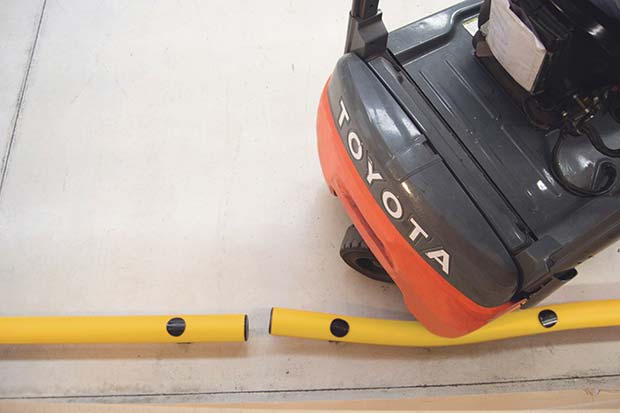Whether used for storage, production or logistics, warehouses are often buzzing with activity. However, with vehicles, equipment and people working alongside one another— as well as static hazards such as shelving or other equipment— the risk of collision can be high. This can seriously endanger worker health and safety and result in costly damage to the building, equipment, and products. Warehouse owners and operators have a legal and moral obligation to prevent accidents like these. One way to do so is by keeping people and machinery separate with measures including installing safety barrier protection.
 Safe workspaces
Safe workspaces
Safety barriers are often part of a facility’s health and safety policy and bring with them several benefits— most notably protecting workers from injury or worse. The Health and Safety Executive (HSE) cite “being hit with a moving vehicle” as one of the most common types of work-related accidents within the storage and warehousing industry. Barriers can help to clearly demarcate spaces and pathways, keeping people and vehicles separate wherever possible to minimise accidents. Often brightly coloured, they also provide a physical reminder of the surrounding hazards, ensuring workers are continually aware of what is happening around them. This should work in tandem with regular health and safety reviews and briefings to make sure every worker knows the correct procedures to keep themselves and others safe.
Safety barriers can also help to protect a business’ vehicular fleet, stock, and the building itself — all considerable investments. In addition to damaging vehicles, collisions into the building structure or its contents can result in costly damage, downtime, and even cause further risk of injury to workers. Safety barriers can help vehicle drivers to safely manoeuvre around a warehouse, especially in high traffic or product areas such as unloading and loading bays. They can even be installed around doors to protect against misjudgements.
Factors to consider when selecting a safety barrier
There are many types of protective barriers, from simple posts to full barriers with gates, to systems that surround and protect doorways. They are typically either solid safety barriers or flexible systems. Solid safety barriers are constructed from a hard synthetic polymer wrapped around a steel anchor to provide robust, rigid impact protection. Flexible systems are made from a more pliable synthetic polymer and have a hollow construction to increase elasticity and allow them to safely absorb and dissipate forces upon impact.
Regardless of the solution, they should always be made from high-quality materials that have been submitted to testing to certify their impact resistance and, if required, food safety. They should be brightly coloured, especially if being used externally, to ensure visibility and make it easy to spot any scratches, dents, or other damage which needs to be repaired. They should also be easy to install, leaving little room for error and allowing easy replacement if impacted and damaged. Some systems use a simple steel anchoring system which have been designed and tested to minimise any damage or cracks to concrete floors if impacted — further protecting the facility.
Protect what matters
Protective barriers are simple, low-cost solutions which can be specified alongside the building envelope to ensure a safe workspace, effective operations, and a productive and profitable business.




Comments are closed.